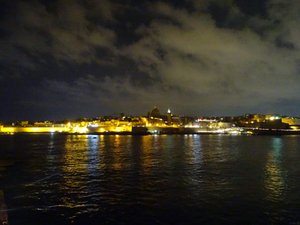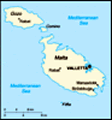Advertisement
Published: September 19th 2019

 Valletta at night
Valletta at night
The view from Sliema looking back to VallettaFrom all directions we converged on the island nation of Malta. Craig came from Berlin, Leanne and Nathan from Melbourne and I came from London. We descended upon the seaside borough of Sliema and got back to what we do best. Holidaying in the sun, that is.
Malta itself is small. The buses from the capital, Valletta, will take you anywhere on the main island in less than an hour. So, we used it as a base for 5 days to see and learn about the culture, history and nature of this place. To start with it is a dry rock, sticking out of the water. Not much grows here and one of the most useful things they have on the island is sandstone. The yellow rocks are quarried and have been for centuries. They used them to build most of the buildings here, including the forts that guard the entrance to the harbour. This was a stronghold of the knights of St. John and they finally defeated their long-time foe, Suleyman the pretty good (he was magnificent until he lost this battle) after a long siege and naval battle. Wars were fought differently then. The Ottomans would cut off

 Valletta in the afternoon
Valletta in the afternoon
Impressive fortified city with cathedral and tower.the heads of fallen knights and float them across the water on crosses for their buddies behind the high walls to see. But the knights of St. John had an abundance of Muslim corpses at their disposal and decided to send some heads back to their enemies using canons. This was before the Geneva convention, which strictly stipulates which body parts can and cannot be used as projectiles in such circumstances.
That was one of many ding-dong battles in this small but strategically located island’s tumultuous history. Of significance is the World War II bombing from Italian planes which forced the population to shelter underground for months and survive in horrible conditions. After the war many Maltese moved to Melbourne in search of more optimistic futures, like people from many other parts of Europe did.
Malta has a coast line made largely of cliffs. This provides dramatic scenery, but not many beaches. There are, however, lots of good swimming spots. We got to a few of them on a Day Cruise from the harbour, departing from just 50 metres from our front door. Sliema is a very convenient location for lots of things, including restaurants, shopping and water

 Marsaxlokk
Marsaxlokk
A fishing village that we visited.transport. The water in many places is stunning blue in colour and very clean. It is the perfect antidote to the warm weather at the end of a long Mediterranean summer. The small island of Camino has the blue lagoon, perhaps the prettiest place to swim in the archipelago. But you would have to share it with thousands of others in a conga-line of patrons passing food outlets, beach (read slightly flatter rocks than elsewhere) umbrellas and an ambulance (not sure why that was needed). So, we were glad that we just went past to see the circus on our way between less busy swimming places.
From Sliema it is easy to catch the half hourly ferry across the harbour to Valletta. There you can wander the medieval streets and admire high fortifications to keep the likes of Suleyman out. There are also lots of churches and we popped our heads inside to inspect one or two as we took in the old world feel of the nation’s heart and soul. There is also a very old hospital, built by the knights of St. John. Its main room is over 150 metres long and housed hundreds of patients. It
was a state-of-the-art hospital and every patient had their own toilet! As well as that the procedure for amputation had been streamlined and could be completed in a matter of seconds. Guillotines were used for this purpose and that must have been very comforting for the patients of the time.
Malta really is a destination for everyone. Leanne, Craig and I have enjoyed the cultural and historical background of the country, whilst Nathan has pointed out every crane and digger that is working to build a multitude of new apartment blocks. He has also taken to critiquing the parking skills of the many parked cars we pass every day. As well as these points of interest to an 8-year-old boy, he met one kid on the day cruise, who he had a great time with. It was the captain’s son, who was only a few years younger than Nathan. The two had a great day and really enjoyed the netting (they thought trampoline) at the front of the catamaran. Paying customers might not have enjoyed their presence as much, but Nathan’s new friend did tell us it was his boat. Who can argue with that?
As far as
Maltese food goes, there are two main influences; heaps of pizza and pasta restaurants and you will have no trouble finding a full English breakfast. If you look a little harder though, you can find some good Maltese restaurants serving traditional dishes. I can recommend the Bragjioli, which is beef olives; thin steaks wrapped around mildly spiced mince and served with peas, potatoes and gravy. We also enjoyed a pork and beef stew. Stews are common on Maltese menus and the one we shared was very tasty. Then there is Maltese wine. The first time I asked a waiter what he recommended, his answer was “try something from Italy”. So, I did. But later on, we gave a local Cabernet Franc a go and were pleasantly surprised. They do make good wine in Malta.
Mdina, the inland former capital of Malta, is well worth a visit and can be reached via public transport from Valletta. It is even nicer than Valletta. The buildings are made from the same yellow sandstone and the walls of the fort are also really high. There is also an impressive cathedral and many other old buildings of the same style to help you fell

 Cathedral at Mdina
Cathedral at Mdina
You had to pay to go inside. So we didn'tlike you have been transported in time. The difference it that from the walled old town you can’t see any modern construction and I guess that the feeling is more authentic.
On our last day here Leanne and I went diving. There are a lot of WWII wreaks under the water. We saw HMAS Maori, which was a destroyer and I was surprised how small it was. It hit the ocean floor in many pieces. Like most of the Mediterranean there isn’t much sea life to see. But that wasn’t what we went for. We had ticked off the last of the things we wanted to do in our 5 day stay and even managed to get a few afternoons in at one of the pool bars facing the sea. Great relaxing time for all of the family. Particularly when Nathan made friends to play with in the pool.
So that’s all from Malta. Next stop is Sicily where we will conduct extensive research on Gelati. That report will be published in the coming week.
Advertisement
Tot: 0.381s; Tpl: 0.013s; cc: 13; qc: 53; dbt: 0.1121s; 1; m:domysql w:travelblog (10.17.0.13); sld: 1;
; mem: 1.2mb



















